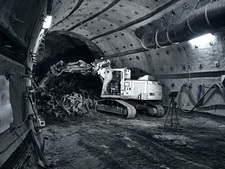How long does it take to convert the Konrad mine into a repository?
The construction and operation of the Konrad repository was licensed in 2002 by the Lower Saxon Environment Ministry, following a plan-approval procedure having lasted twenty years. On 26 March 2007, the licence for Konrad was also confirmed by the Federal Administrative Court.
Since then, the Federal Office for Radiation Protection (BfS) has been processing the existing planning and licensing documents mainly originating from the 1980s. Until then, the political requirement of the federal governments had been not to deal with the planning documents for the Konrad repository during the examination by the licensing authority and the court actions, that is, they could not be adapted to the state of the art of science and technology.
This requirement was based on the apprehension that alterations of the procedural documents could jeopardise the legal certainty of the plan-approval decision. Besides, one wished to avoid unnecessary costs on account of the mine being not suitable or the project being given up.
Parties involved
The overall responsibility for the construction and operation of repositories is with the Federal Office for Radiation Protection. In 1984, the federal government commissioned the German Company for the Construction and Operation of Waste Repositories ("Deutsche Gesellschaft zum Bau und Betrieb von Endlagern für Abfallstoffe mbH", DBE) to „plan and construct federal facilities for the long-term storage and disposal of radioactive waste”. By contract, the DBE was conceded a monopoly on these tasks. Thus, the BfS (formerly the "Physikalisch-Technische Bundesanstalt", PTB) is bound to the DBE via the Co-operation Agreement of 1984.
While the BfS has the role of operator and builder, the DBE carries out the planning and construction of the Konrad repository as a public construction project. The DBE co-ordinates the construction process and is responsible for the plan of execution. For technical works, the DBE mainly commissions external companies. The DBE is obliged to keep the operator informed for example about the development of costs and the status of implementation. The BfS steers the entire project, co-ordinating the numerous procedures with the competent licensing authorities.
A large number of other protagonists (such as supervisory and licensing authorities and contractors) are involved in the complex tasks of constructing the Konrad repository. Some do only participate in individual, marked-off measures, others in the construction of the core facilities over a longer period of time, others again as superior authorities or supervising institutions.
Among the authorities whose decisive functions could influence the realisability and duration of the Konrad mine’s conversion into a repository significantly, are for example the Federal Ministry for the Environment, Nature Conservation and Nuclear Safety (BMU), the Lower Saxon Ministry for the Environment and Climate Protection (NMU), "Landesamt für Bergbau, Energie und Geologie" (Länder Office for Mining, Energy and Geology, LBEG), Lower Saxon Ministry for Social Affairs, Women, Family, Health and Integration (NMS), the Federal Railway Authority (EBA) and the Lower Saxon Ministry of the Interior and Sports (NMI). A detailed survey of the institutions involved and their functions is available here.
Updating of previous plans
After the Federal Administrative Court had confirmed the plan-approval decision issued in 2007 by Lower Saxony and after the federal government had been given the all-clear for the construction, the BfS and the DBE could start processing systematically the plans, parts of which were over 20 years old, cost accounting and the time required for the construction of the facility according to the state of the art of science and technology. At the same time, one needed to implement more than 500 collateral clauses included in the plan-approval decision.
The first thing now is to correct the unrealistic assumptions relating to the conversion of the Konrad mine into a repository with which disposal was presented as a cost-efficient method that could be implemented in short time. The adaptation of the plan to the state of the art of science and technology and to the amended legal provisions has shown that it will take clearly longer. With the support of external consultants, the BfS and the DBE are working on methods to shorten the time required for construction.
Expert examination
The schedules updated by the DBE stating that the repository will be completed in 2019, were the reason for an expert examination whose conduction was commissioned to the "Energiewerke Nord" (EWN) by the Federal Ministry of Finance. The resulting report of the Contex Consulting company confirms to a substantial extent the BfS’s own analyses, indicating that in particular unrealistic assumptions of the 1980s and 1990s caused the planning corrections. The report, however, also attests the protagonists that the project runs “surprisingly well” after initial difficulties. “The positive progress in the project is significantly larger than one could assume from the open questions or problems always pushing to the fore.”
In their analysis, the EWN experts have especially focussed on the co-operation between the BfS and the DBE. Further essential aspects, such as interfaces with other protagonists that might lead to time shifting, are not considered sufficiently. The BfS evaluates the recommendations of the expert report and has additionally commissioned an external, independent expert to examine the open questions in order to be able to name all things potentially speeding up the construction of the Konrad repository.
The BfS considers a safe and speedy conversion of the Konrad mine into a repository essential. This is a great challenge for all parties involved, where all protagonists need to assume responsibility for their tasks.
State of 2013.04.17


